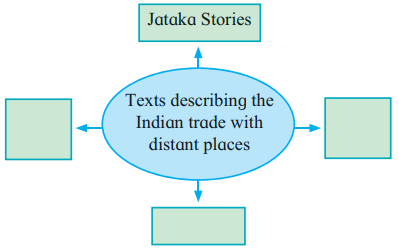India, Nations in the northwest of the Indian Subcontinent and China
Q.1 (A) Choose the correct alternative and write the complete sentences.
(1) The coin hoards found in _______ had Roman gold coins in it.
(a) Tamilnadu (b) Maharashtra
(c) Karnataka (d) Kerala
Answer: (a) Tamilnadu
(2) The famous king Hammurabi had ruled the kingdom of ______ .
(a) Syria (b) Babylon
(c) China (d) Greece
Answer: (b) Babylon
(3) The route that links Asia and ______ is referred as the ‘Silk Route’.
(a) Europe (b) Africa
(c) America (d) Russia
Answer: (a) Europe
(4) ‘White Horse Temple’ is the first Buddhist temple built in ______ .
(a) India (b) Japan
(c) China (d) Egypt
Answer: (c) China
(B) Find the incorrect pair from set B and write the correct ones.
| Set ‘A’ | Set ‘B’ |
| (1) Strabo | Geographia |
| (2) Pliny the Elder | Naturalis Historia |
| (3) Hippalus | Hippokura |
| (4) Arrian | Indica |
Answer: (3) Hippalus – Periplus of the Erythrean Sea
(C) Write the names.
(1) A place in the Gandhara region enlisted as a World Cultural Heritage: Takht-i-Bahi.
(2) Buddhist monks in the 4th century B.C.E. who translated many Buddhist texts in Chinese language: Kumarjeeva
Q.2 Complete the concept map.
Answer:
Q.3 Explain the following statements with reason.
(1) Buddhism reached China during Kushana period .
Answer: Reason: During the Kushana period, under Emperor Kanishka, Buddhism spread significantly due to the empire’s control over trade routes, including the Silk Route connecting India to China. Kanishka’s patronage of Buddhism, as evidenced by coins bearing Gautama Buddha’s image, facilitated the movement of Buddhist monks and texts to China. The document notes that Buddhism began spreading to China in the 1st century C.E., aligning with the Kushana period, as monks like Kashyapa Matang and Dharmaraksha traveled to China, carrying Buddhist texts.
(2) The merchants rarely used the shorter line of the Silk Route.
Answer: Reason: The shorter line of the Silk Route, crossing the steppes to the north, was less frequently used because it was infested with troublesome pastoral tribes, making it unsafe. Additionally, it lacked accommodation and food facilities, unlike the main route that connected oasis cities offering markets, lodging, and provisions, as mentioned in the document.
Q.4 Give your opinion.
There were close cultural associations between the Gandhara region and India before the advent of Islam.
Answer: Opinion: I agree with the statement. The Gandhara region (modern-day Afghanistan and Pakistan) had deep cultural ties with India, primarily through Buddhism and trade. The document highlights Emperor Ashoka’s influence, with his edicts in Greek and Aramaic found in Kandahar, indicating Gandhara’s integration into his empire. Buddhist monks sent by Ashoka spread teachings in the region, and sites like Shahji-ki-Dheri and Takht-i-Bahi, with their stupas and viharas, reflect strong Buddhist cultural links. Additionally, the discovery of Hindu deities like Ganesha and Surya in Afghanistan further confirms the shared cultural and religious heritage before Islam’s arrival.
Q.5 Write short notes.
(1) Shahji-ki-Dheri
Answer: Shahji-ki-Dheri, near Peshawar in Pakistan, is an significant archaeological site excavated to reveal a stupa from the Kushana period, known as ‘Kanishka’s Stupa’. Built during Emperor Kanishka’s reign, it housed sacred remains of Gautama Buddha in a box (karandaka) with an inscription mentioning ‘Agnishala’, the supervisor of the Kanishka Vihara within the Mahasena Sangharama. The box is now preserved in the Peshawar Museum, underscoring the site’s importance in Buddhist history.
(2) The Bamiyan Buddhas:
Answer: The Bamiyan Buddhas were two monumental standing statues (53 meters and 38 meters tall) carved into a cliff in Bamiyan, Afghanistan, 250 km west of Kabul. Created in the 1st to 7th centuries C.E., they were made with a sandstone core plastered with mud and straw, adorned with gold and precious stones. Surrounded by 750 caves with Buddhist murals, they were a significant cultural site. Destroyed by the Taliban in 2001, restoration efforts by UNESCO and countries like Japan have rediscovered murals and a 19-meter Mahaparinibbana Buddha image, highlighting their global heritage value.
Q.6 Answer the following question with the help of given points. Write about the ties between ancient India and China.
a) Trade Relations:
Answer: Ancient India and China were connected through the Silk Route, a network of trade lines linking Asia and Europe. The document describes how this route facilitated the exchange of goods, with two lines reaching Taxila from China’s Xinjiang province via Kashgar and Yarkand. Indian merchants exported commodities like silk, spices, and precious stones, while Chinese goods, including silk, were traded in oasis cities along the route. These trade interactions fostered economic ties and cultural exchanges between the two regions.
b) The Spread of Buddhism in China:
Answer: Buddhism spread to China from India during the 1st century C.E., particularly under the Kushana period. The Han dynasty’s expansion to Central Asia enabled this transmission via the Silk Route. In 67 C.E., two Buddhist monks, Kashyapa Matang and Dharmaraksha, accompanied Chinese representatives to China, carrying Buddhist texts on white horses. They translated these texts, and the White Horse Temple, the first Buddhist temple in China, was built in their honor. By the 4th to 6th centuries C.E., Buddhism gained popularity, with monks like Kumarjeeva translating texts and both Theravada and Mahayana sects establishing roots in China.
c) Serendian Art Style:
Answer: The spread of Buddhism introduced the Serendian art style in China’s Xinjiang province, blending Greek, Persian, and Chinese influences with Gandhara art. Originating in the 1st century C.E., this style was inspired by Mahayana Buddhist monks from Central Asia. It featured sculptures of Gautama Buddha and Bodhisattvas, as noted during Sir Aurel Stein’s surveys. The style influenced Chinese Buddhist art, evident in rock-cut caves like Dunhuang’s Mogao Caves, which contain numerous sculptures and murals, reflecting India’s artistic impact on China.



Leave a Reply